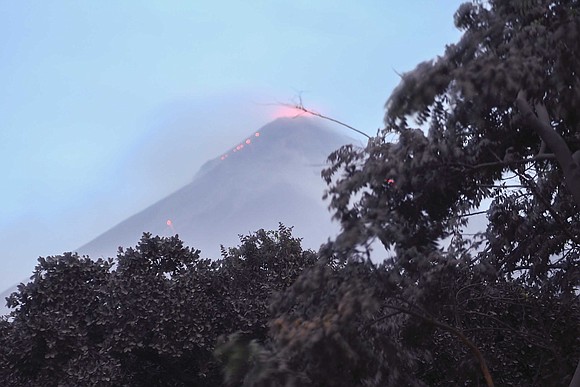Guatemalans struggle to recover the dead buried by volcano eruption
CNN/Stylemagazine.com Newswire | 6/5/2018, 11:31 a.m.
By Madison Park, Jason Hanna and Flora Charner, CNN
(CNN) -- Maria Leticia has been grappling with the fear that her relatives didn't escape from the hot gases, rock and ash that killed dozens as the deadly mixture raced down Guatemala's Fuego volcano.
"My two grandsons," she cried Monday, looking for them and her daughter a day after the eruption that reportedly left at least 69 dead. "They didn't let anyone through. ... We didn't see anyone that could help us. Oh God, my daughter!"
Towns were engulfed by thick, heavy ash from Sunday's sudden eruption, blocking roads and leaving behind steaming debris that rescuers had trouble navigating.
Dazed residents have been holding funerals for the dead, even as recovery workers brace for the likelihood of finding more bodies when they reach hillside areas overrun by the volcanic flow.
In Alotenango, a town a few miles east of the volcano, recovery workers and families hugged one another Monday under a tent in front of a few caskets holding remains of victims, video from Reuters shows.
Later Monday, hundreds gathered in a street as men somberly carried the caskets above their shoulders in a funeral procession.
A sobbing woman who lives in the town of Los Lotes told CNN en Español: "My mother's house was buried with my entire family inside ... my three sons, two daughters and my grandson. My mother, my sisters, my nieces and nephews."
Firefighters and other recovery workers continued their searches, and there was at least a glimmer of hope in the ash in a video released Monday by Guatemala's National Civil Police. It showed an officer rescuing a baby girl from a home covered in volcanic ash. The baby appeared to be safe and unharmed.
Recovery workers have had difficulty breathing in the hazardous conditions. And heat from the ground has been so intense that the soles of some firefighters' boots were tearing off and they were having to walk on wooden planks.
"It is very, very difficult due to the fact that it's very, very hot," volunteer firefighter Mario Cifuentes said Monday. "The soil is very unstable. We cannot be walking around. ... The shoes, they've been completely destroyed because of the heat."
Ash and gases have covered large areas of ground, said Diego Ibarguen, who works for a firefighter support organization and flew a drone over areas awash in ash.
"Basically there's no houses left, and to my assumption there's nobody left there ... except the people doing the search and rescue," he said. "The sad news is there's a bunch of recovery of bodies of children and adults there."
Guatemala is observing three days of official mourning. Officials said more eruptions could be on the way.
'We saw the lava ... pouring through the cornfields'
The Fuego volcano unleashed fast-moving pyroclastic flow -- a nasty mix of ash, rock and volcanic gases that can race down a volcano at hundreds of kilometers per hour, much faster than people or even cars. They're known to destroy nearly everything in their path, according to the US Geological Survey.
So far, 17 people who died have been identified, according to Guatemala's National Institute of Forensic Sciences. Most of the victims were from the city of Hunapu in Escuintla state.
At least 15 people have been hospitalized, including 12 children -- some of whom suffered severe burns, the nation's health ministry said.
Displaced from their homes, survivors were anguished over the whereabouts of their loved ones. Bodies mounted at a morgue as families wailed in agony.
On Sunday, Consuelo Hernandez told CONRED, the Guatemalan disaster relief agency, that some of her relatives were buried.
"Not everyone escaped. I think they were buried," Hernandez said in a video released by CONRED. "We saw the lava was pouring through the cornfields, and we ran toward a hill."
Guatemalan President Jimmy Morales asked people to stay calm and to work together during the disaster.
"We would also like to ask for your patience because we need to ensure, not only the security of our rescue workers, but the integrity of those people who may still be alive," Morales told reporters and rescue workers Monday in Escuintla.
More than 3,100 people have been evacuated, and the eruption has affected 1.7 million people, according to CONRED.
The impact of the fire volcano
Volcan de Fuego, which means fire volcano, is one of Central America's most active and is near the colonial city of Antigua.
The eruption was visible even from space as satellite footage showed a massive dark gray ash cloud.
The villages were right on the foothills of the mountain, making it difficult to escape. And authorities urged residents living near the volcano to evacuate immediately and warned some in Chimaltenango, Sacatepéquez and Escuintla states to watch out for volcanic rocks and ash.
Sunday's explosion rained soot over the popular tourist destination and other villages in the Sacatepéquez state, covering them in ash.
Some ash reached the capital of Guatemala City about 25 miles away, temporarily forcing the closure of its international airport. Officers were clearing the runway with brooms in images shared by the Guatemalan army.
The eruption officially ended late Sunday, said Guatemala's National Institute of Seismology, Vulcanology, Meteorology and Hydrology.
But it warned there could be new eruptions, and residents in the surrounding areas should be on alert for mudslides containing volcanic material.




